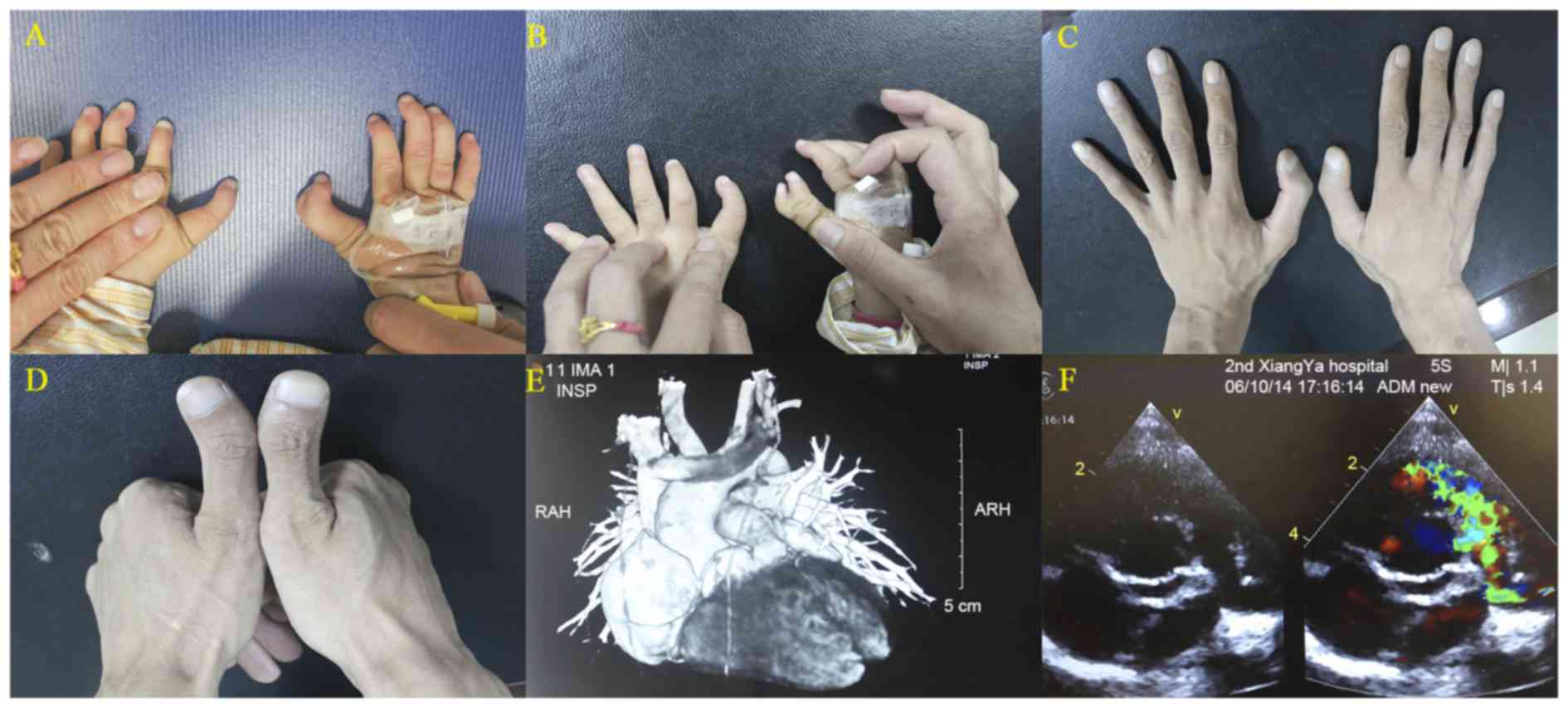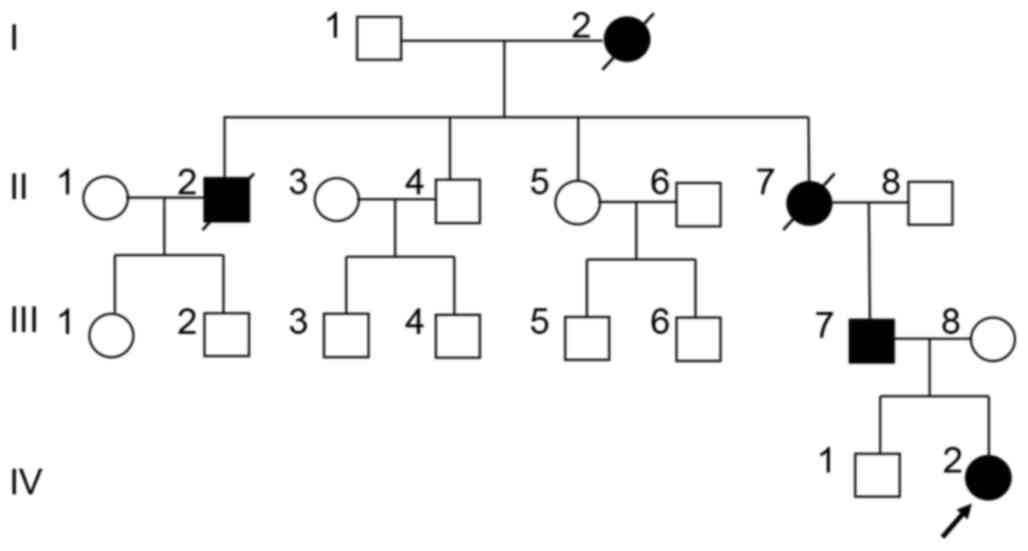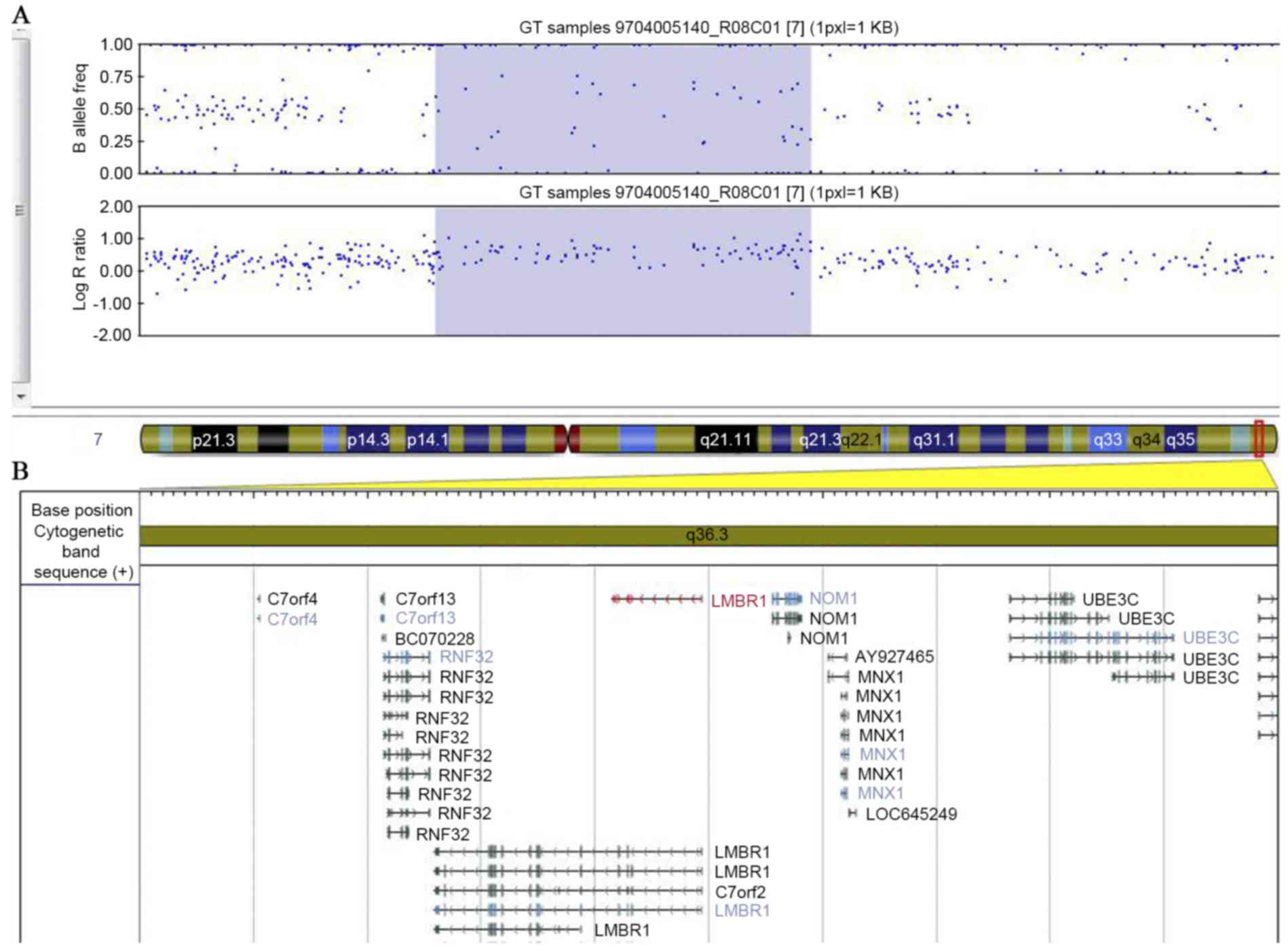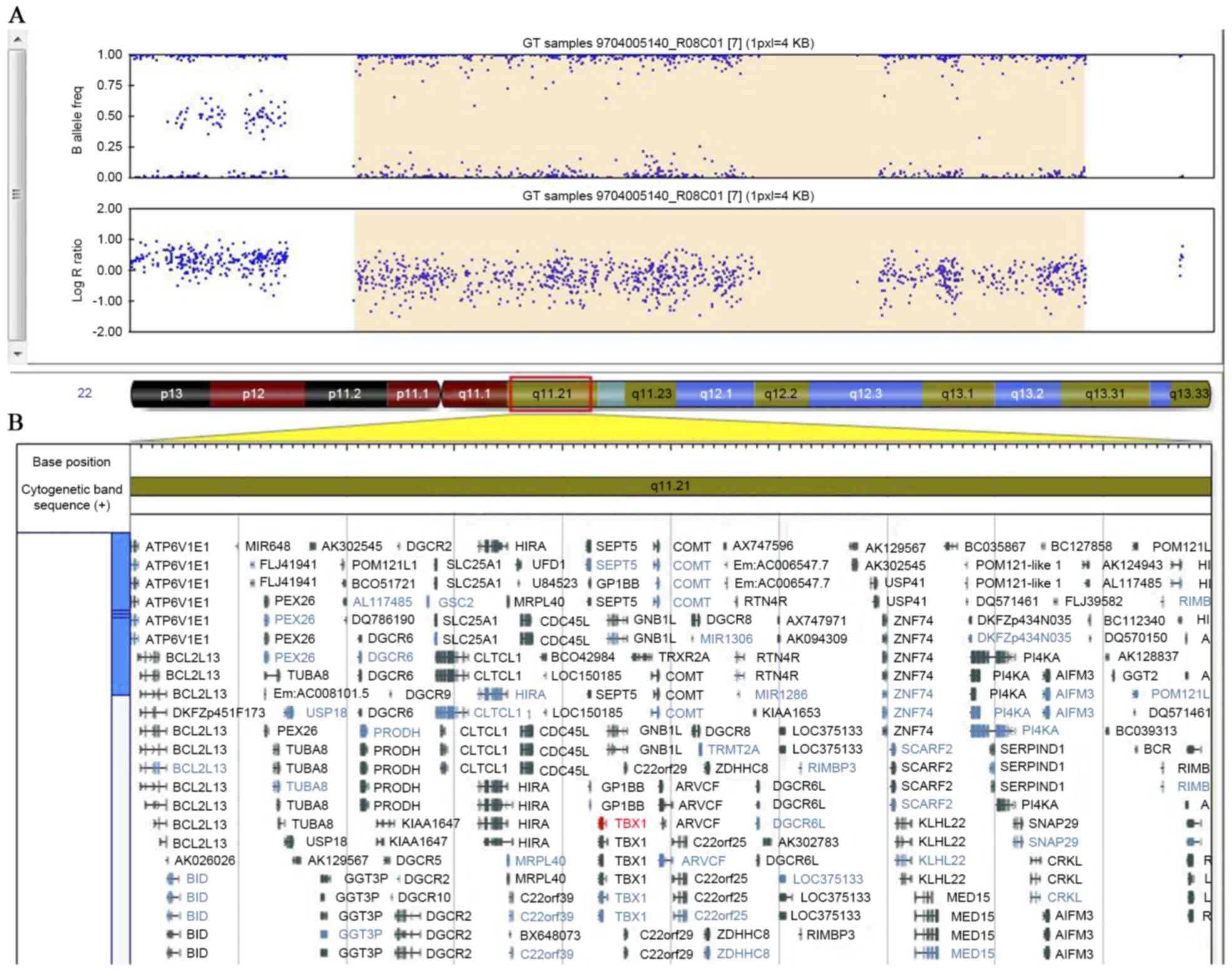|
1
|
Tsukurov O, Boehmer A, Flynn J, Nicolai
JP, Hamel BC, Traill S, Zaleske D, Mankin HJ, Yeon H and Ho C: A
complex bilateral polysyndactyly disease locus maps to chromosome
7q36. Nat Genet. 6:282–286. 1994. View Article : Google Scholar : PubMed/NCBI
|
|
2
|
Hill RE: How to make a zone of polarizing
activity: Insights into limb development via the abnormality
preaxial polydactyly. Dev Growth Differ. 49:439–448. 2007.
View Article : Google Scholar : PubMed/NCBI
|
|
3
|
Radhakrishna U, Blouin JL, Solanki JV,
Dhoriani GM and Antonarakis SE: An autosomal dominant triphalangeal
thumb: Polysyndactyly syndrome with variable expression in a large
Indian family maps to 7q36. Am J Med Genet. 66:209–215. 1996.
View Article : Google Scholar : PubMed/NCBI
|
|
4
|
Lettice LA, Horikoshi T, Heaney SJ, van
Baren MJ, van der Linde HC, Breedveld GJ, Joosse M, Akarsu N,
Oostra BA, Endo N, et al: Disruption of a long-range cis-acting
regulator for Shh causes preaxial polydactyly. Proc Natl Acad Sci
USA. 99:7548–7553. 2002. View Article : Google Scholar : PubMed/NCBI
|
|
5
|
Lettice LA, Heaney SJ, Purdie LA, Li L, De
Beer P, Oostra BA, Goode D, Elgar G, Hill RE and de Graaff E: A
long-range Shh enhancer regulates expression in the developing limb
and fin and is associated with preaxial polydactyly. Hum Mol Genet.
12:1725–1735. 2003. View Article : Google Scholar : PubMed/NCBI
|
|
6
|
Sagai T, Masuya H, Tamura M, Shimizu K,
Yada Y, Wakana S, Gondo Y, Noda T and Shiroishi T: Phylogenetic
conservation of a limb-specific, cis-acting regulator of Sonic
hedgehog (Shh). Mamm Genome. 15:23–34. 2004. View Article : Google Scholar : PubMed/NCBI
|
|
7
|
Gurnett CA, Bowcock AM, Dietz FR,
Morcuende JA, Murray JC and Dobbs MB: Two novel point mutations in
the long-range SHH enhancer in three families with triphalangeal
thumb and preaxial polydactyly. Am J Med Genet A. 143A:27–32. 2007.
View Article : Google Scholar : PubMed/NCBI
|
|
8
|
Wang ZQ, Tian SH, Shi YZ, Zhou PT, Wang
ZY, Shu RZ, Hu L and Kong X: A single C to T transition in intron 5
of LMBR1 gene is associated with triphalangeal thumb-polysyndactyly
syndrome in a Chinese family. Biochem Biophys Res Commun.
355:312–317. 2007. View Article : Google Scholar : PubMed/NCBI
|
|
9
|
Al-Qattan MM, Al Abdulkareem I, Al Haidan
Y and Al Balwi M: A novel mutation in the SHH long-range regulator
(ZRS) is associated with preaxial polydactyly, triphalangeal thumb,
and severe radial ray deficiency. Am J Med Genet A. 158A:2610–2615.
2012. View Article : Google Scholar : PubMed/NCBI
|
|
10
|
Klopocki E, Ott CE, Benatar N, Ullmann R,
Mundlos S and Lehmann K: A microduplication of the long range SHH
limb regulator (ZRS) is associated with triphalangeal
thumb-polysyndactyly syndrome. J Med Genet. 45:370–375. 2008.
View Article : Google Scholar : PubMed/NCBI
|
|
11
|
Sun M, Ma F, Zeng X, Liu Q, Zhao XL, Wu
FX, Wu GP, Zhang ZF, Gu B, Zhao YF, et al: Triphalangeal
thumb-polysyndactyly syndrome and syndactyly type IV are caused by
genomic duplications involving the long range, limb-specific SHH
enhancer. J Med Genet. 45:589–595. 2008. View Article : Google Scholar : PubMed/NCBI
|
|
12
|
Luo C, Yang YF, Yin BL, Chen JL, Huang C,
Zhang WZ, Wang J, Zhang H, Yang JF and Tan ZP: Microduplication of
3p25.2 encompassing RAF1 associated with congenital heart disease
suggestive of Noonan syndrome. Am J Med Genet A. 158A:1918–1923.
2012. View Article : Google Scholar : PubMed/NCBI
|
|
13
|
Tan ZP, Huang C, Xu ZB, Yang JF and Yang
YF: Novel ZFPM2/FOG2 variants in patients with double outlet right
ventricle. Clin Genet. 82:466–471. 2012. View Article : Google Scholar : PubMed/NCBI
|
|
14
|
Masuya H, Sezutsu H, Sakuraba Y, Sagai T,
Hosoya M, Kaneda H, Miura I, Kobayashi K, Sumiyama K, Shimizu A, et
al: A series of ENU-induced single-base substitutions in a
long-range cis-element altering Sonic hedgehog expression in the
developing mouse limb bud. Genomics. 89:207–214. 2007. View Article : Google Scholar : PubMed/NCBI
|
|
15
|
Beckmann JS, Estivill X and Antonarakis
SE: Copy number variants and genetic traits: Closer to the
resolution of phenotypic to genotypic variability. Nat Rev Genet.
8:639–646. 2007. View
Article : Google Scholar : PubMed/NCBI
|
|
16
|
Sharpe J, Lettice L, Hecksher-Sorensen J,
Fox M, Hill R and Krumlauf R: Identification of sonic hedgehog as a
candidate gene responsible for the polydactylous mouse mutant
Sasquatch. Curr Biol. 9:97–100. 1999. View Article : Google Scholar : PubMed/NCBI
|
|
17
|
Goodship J, Cross I, LiLing J and Wren C:
A population study of chromosome 22q11 deletions in infancy. Arch
Dis Child. 79:348–351. 1998. View Article : Google Scholar : PubMed/NCBI
|
|
18
|
Botto LD, May K, Fernhoff PM, Correa A,
Coleman K, Rasmussen SA, Merritt RK, O'Leary LA, Wong LY, Elixson
EM, et al: A population-based study of the 22q11.2 deletion:
Phenotype, incidence, and contribution to major birth defects in
the population. Pediatrics. 112:101–107. 2003. View Article : Google Scholar : PubMed/NCBI
|
|
19
|
Yagi H, Furutani Y, Hamada H, Sasaki T,
Asakawa S, Minoshima S, Ichida F, Joo K, Kimura M, Imamura S, et
al: Role of TBX1 in human del22q11.2 syndrome. Lancet.
362:1366–1373. 2003. View Article : Google Scholar : PubMed/NCBI
|
|
20
|
Shprintzen RJ: Velo-cardio-facial
syndrome: 30 Years of study. Dev Disabil Res Rev. 14:3–10. 2008.
View Article : Google Scholar : PubMed/NCBI
|
|
21
|
Momma K: Cardiovascular anomalies
associated with chromosome 22q11.2 deletion syndrome. Am J Cardiol.
105:1617–1624. 2010. View Article : Google Scholar : PubMed/NCBI
|













